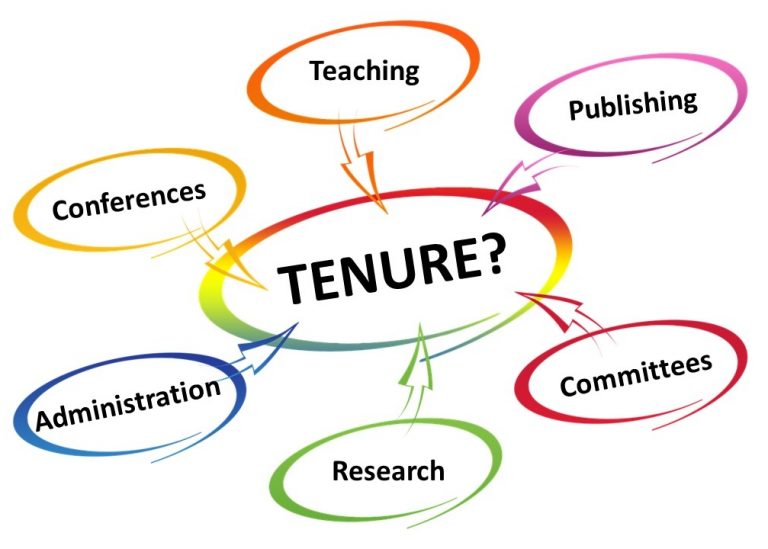Learning Objectives
- Describe the rank and tenure system embedded in higher education institutions.
- Articulate the connection between the rank and tenure system and scholarly publishing.
In the previous chapter, we introduced the scholarly publishing system and stated that it is embedded in academia. What, exactly, does that mean? Why is this important?
Certainly, scholarly publishing exists to birth and share new knowledge so that it might lead to discovery, innovation, and improvements in society — advancements in everything from agriculture to healthcare to second language acquisition and beyond.
But scholarly publishing also exists because it is expected of faculty members at colleges and universities. It’s part of their job. In fact, if they neglect it, they may risk losing their career. You may have heard the phrase “publish or perish,” which refers to the pressure that faculty members face to produce and publish scholarly material in order to maintain their position. This is especially true of untenured faculty members.
So: what is tenure? What does it mean?
According to the American Association of University Professors, tenure is:
When a person first lands an academic faculty position, they are usually appointed to the rank of Assistant Professor. Then, typically over the next six years, they are “on tenure track,” meaning that they are working toward achieving tenure by making substantive contributions to both their institution and their field/discipline through three primary areas: teaching, research/scholarship, and service. At periodic points throughout those six years, they must show evidence of their progress, receive feedback from their peers and tenure committee, and respond and adapt accordingly. There are many factors that shape the outcome of a tenure decision, but conducting research — and publishing that research — is vitally important.

Ultimately, if a faculty member successfully secures tenure, they are (usually) promoted to Associate Professor. In some universities, faculty members continue to be reviewed post-tenure, and they may choose to pursue appointment to Full Professor through additional accomplishments in teaching, research/scholarship, and service. The rank progression commonly looks like this:

Although individual institutions’ criteria for awarding tenure and promotion vary (as do the specifics of their review processes), one near-universal commonality is the emphasis on scholarly publication. Faculty members need to do research/scholarship and publish their work in a scholarly venue, typically a scholarly journal. And in order to do their research, they need to be able to access and read the existing published scholarly literature, to understand what others in their field have already done and to engage, build on, or interrogate that work in some way. (Students too, of course, must use scholarly literature to understand course content, complete assignments, write research papers, etc. throughout their academic career.)
In summary, because faculty members must both consume and produce scholarly knowledge, often in the form of published scholarly journal articles, academic culture is inextricably tied to the scholarly publishing system. One cannot exist without the other.
Exercise: Promotion and Tenure in Real Life
For a more complete picture of the promotion and tenure (P&T) process, let’s examine some current policies, procedures, and processes in place at different U.S. institutions. With a partner or in a small group, choose one of the following schools:
- Boise State University
- Purdue University, West Lafayette campus
- Creighton University
- Oregon State University
Read over the policy and consider these questions:
- What must a faculty member do to achieve tenure in this particular environment?
- What stands out to you? What is most surprising?
- What is clear and what is confusing? Is there language that is unfamiliar? If you were a faculty member reading this document, what questions or concerns might you have?
- Who has responsibilities, and what are they, according to this document?
- Are expectations for faculty clearly defined? How is performance measured?
- Who makes the final decision as to whether or not tenure is granted?
- Does this policy specifically address research activity and scholarly publishing? If so, what does it say about it?
- Other things you notice or want to ask
[Note to Instructors: Alternatively, you can use your own institution’s policy, or another example you find online. Following the small group discussions, reconvene the class and ask the groups to report back on their conversation.]
Additional Readings & Resources
Harley, D. (2013, October). Scholarly communication: Cultural contexts, evolving models. Science, 342(6154), 80-82. 10.1126/science.1243622
Schimanski, L. A., & Alperin, J. P. (2018). The evaluation of scholarship in academic promotion and tenure processes: Past, present, and future. F1000Research, 7, 1605. https://doi.org/10.12688/f1000research.16493.1
Strunk, K. K. (2020, March 13). Demystifying and democratizing tenure and promotion. Inside Higher Ed. https://www.insidehighered.com/advice/2020/03/13/tenure-and-promotion-process-must-be-revised-especially-historically-marginalized
- American Association of University Professors, "Tenure." https://www.aaup.org/issues/tenure ↵
